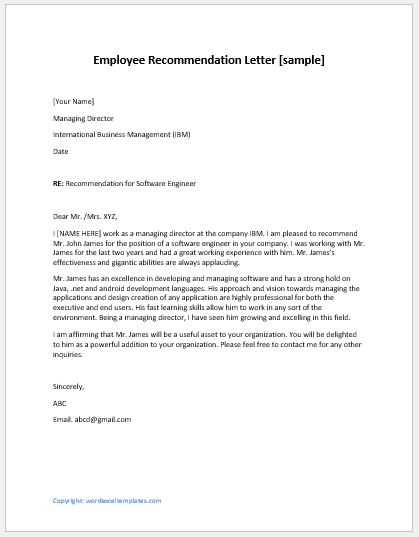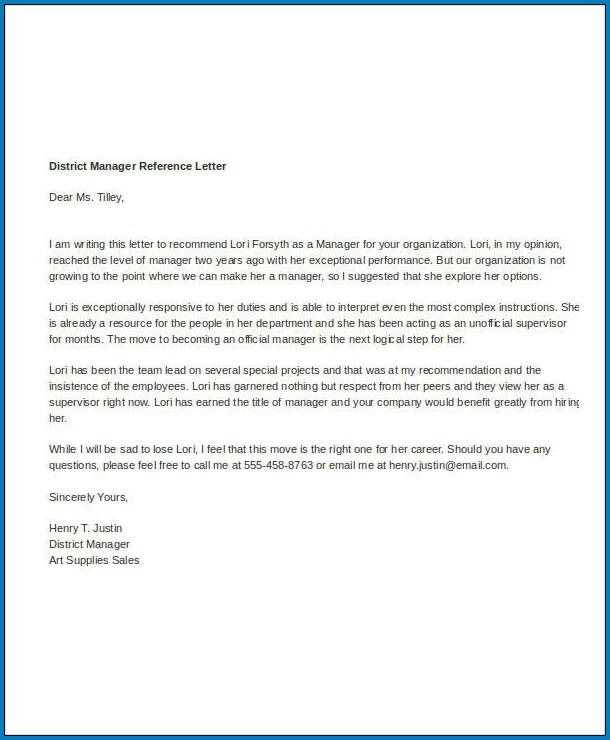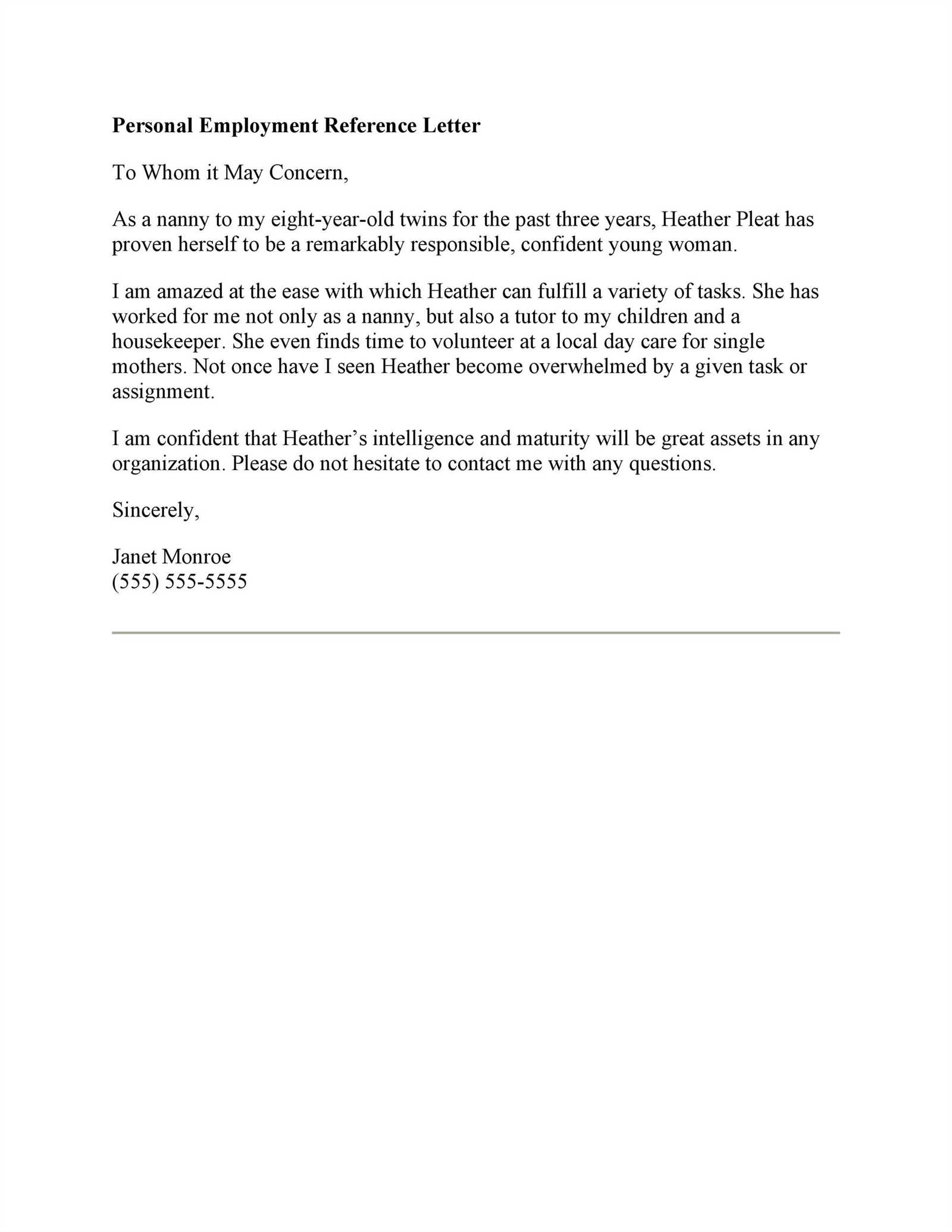Reference letter for employee from manager template

Use this template to create a strong reference letter that highlights the key strengths and contributions of your employee. A well-written letter helps the recipient understand the value the employee brings and why they would be a great fit for the position.
Start by addressing the recipient directly with a clear and respectful salutation. Mention the employee’s name and your position in the company to provide context. Briefly explain the purpose of the letter, outlining the employee’s role and how long they’ve worked with you. A concise introduction ensures the reader understands the background of the employee.
Focus on specific examples of the employee’s achievements. Highlight projects, responsibilities, or skills that made the employee stand out. Describe the impact they had on the team, company, or any improvements they initiated. Using concrete examples makes your reference letter more credible and persuasive.
Conclude with a strong endorsement. State clearly why you recommend the employee and express your confidence in their ability to succeed in their next role. Reaffirm your support and offer to provide further details if needed. A positive closing leaves a strong impression and reinforces the value of your recommendation.
Reference Letter for Employee from Manager Template
A well-crafted reference letter can make a significant impact when recommending an employee. When writing a reference letter for an employee, it’s important to focus on their strengths, skills, and contributions during their time with the company. This template provides a structure to highlight these key points clearly and professionally.
Template for Reference Letter
Dear [Recipient’s Name],
I am pleased to write this reference letter for [Employee’s Name], who worked under my supervision at [Company Name] as a [Employee’s Position] from [Start Date] to [End Date]. During this time, [Employee’s Name] consistently demonstrated strong skills in [mention specific skills or tasks related to their job] and was an asset to our team.
One of [Employee’s Name]’s key strengths is their ability to [specific achievement or skill], which was particularly evident when [describe a specific instance or project]. Their dedication to [mention specific qualities like punctuality, responsibility, teamwork] was clear throughout their employment, and they often went beyond the requirements of the role to [mention any additional contributions].
In addition to their technical abilities, [Employee’s Name] displayed excellent communication and interpersonal skills. They worked well with both colleagues and clients, contributing to a positive working environment. Their ability to manage tasks and collaborate with others made them a valuable team member. I am confident that [Employee’s Name] will excel in any future endeavors they pursue.
I highly recommend [Employee’s Name] for any position they seek and believe they would be a valuable addition to your team. If you have any further questions, feel free to contact me at [Your Contact Information].
Sincerely,
[Your Name]
[Your Position]
[Company Name]
Key Elements of a Strong Reference Letter
| Element | Description |
|---|---|
| Introduction | State your relationship with the employee, including the role and duration of employment. |
| Strengths and Skills | Highlight key skills and achievements, providing specific examples where possible. |
| Communication and Teamwork | Comment on the employee’s ability to collaborate, interact, and contribute to a team environment. |
| Conclusion | Reaffirm your recommendation and offer to provide additional information if needed. |
By following this template, you can create a clear, concise, and compelling reference letter that effectively supports the employee’s future career opportunities. Each section is designed to focus on the qualities that matter most to potential employers, ensuring your recommendation has the right impact.
How to Start a Reference Letter for an Employee

Begin with a clear, direct statement that confirms your role and your relationship to the employee. This establishes credibility from the outset. Mention how long you have known the individual and in what capacity you worked together. For example, “I have had the pleasure of managing [Employee’s Name] for the past three years in the role of [Job Title].” This sets the stage for the rest of the letter and provides context for your assessment.
Next, quickly highlight the employee’s key qualities or achievements that you will focus on in the letter. For example, “During our time working together, [Employee’s Name] demonstrated outstanding [skills/qualities], which significantly contributed to [specific outcomes].” This makes it clear from the beginning what the reader can expect.
Avoid overly formal language or lengthy introductions. Be concise and focused, as this ensures the reader stays engaged and understands the purpose of the letter immediately. This method also allows you to build a strong foundation for the more detailed examples and evaluations that will follow.
Key Information to Include About the Employee’s Role
Describe the specific duties the employee was responsible for. Focus on the tasks they performed regularly and highlight the areas where they made the biggest impact. For example, if they led a team, mention the number of people they managed and the type of projects they oversaw.
Include any notable accomplishments or milestones during their time in the role. If the employee contributed to a project that improved efficiency, reduced costs, or increased revenue, make sure to include the details. Quantify results whenever possible to give concrete evidence of their contributions.
Clarify the skills and qualifications the employee demonstrated while in the role. Mention any specific tools, software, or methodologies they used successfully. If they developed expertise in certain areas, such as project management or client relations, highlight these strengths.
Provide context about how the employee interacted with others within the company. Did they collaborate with other teams, coordinate across departments, or engage with clients directly? This will help showcase their ability to communicate and work effectively in various situations.
Finally, mention the employee’s work ethic and attitude. Were they reliable, proactive, or detail-oriented? Specific examples can help show how their approach benefited the team or organization.
How to Describe the Employee’s Skills and Achievements
Focus on concrete examples of how the employee’s skills directly contributed to the success of the team or company. Mention specific tasks or projects where they demonstrated expertise and leadership. Highlight the impact of their work with measurable results, such as increased efficiency, cost savings, or improved performance metrics.
Provide Specific Examples
Describe situations where the employee solved problems or tackled challenges. For example, “John managed the redesign of the customer service process, which resulted in a 20% reduction in response time.” This shows their ability to apply skills to achieve tangible outcomes.
Showcase Key Strengths
- Technical skills: Specify their proficiency with tools, software, or methodologies, such as “Maria quickly mastered the new CRM software and trained the team in its use.”
- Problem-solving: Highlight instances where the employee found creative solutions. For example, “James identified inefficiencies in our supply chain, implementing a new tracking system that cut delivery delays by 15%.”
- Collaboration: Point out their teamwork and communication skills. For example, “Anna played a pivotal role in facilitating cross-department collaboration, which improved project delivery timelines by 30%.”
By focusing on specific actions and results, you can paint a clear picture of the employee’s strengths and contributions. This helps to create a strong recommendation based on real achievements.
Crafting a Positive but Honest Evaluation of Performance
Focus on specific achievements and skills that highlight the employee’s contributions. Point out how they’ve addressed challenges and delivered results, giving clear examples of projects or tasks where they excelled. Be honest about areas where growth is needed, but frame these observations as opportunities for further development. Use concrete facts rather than generalizations to avoid ambiguity.
Providing Constructive Feedback
Avoid making vague statements. For example, instead of saying “needs to improve,” specify how the employee can enhance their skills. If they missed deadlines, mention how improving time management or communication could help. Recognize their effort in tackling areas that require improvement, but be transparent about expectations moving forward.
Striking the Right Balance
A positive evaluation includes both praise and areas for improvement, but the key is balance. Make sure to highlight their strengths in a way that reinforces their value while being clear about where they could enhance their performance. Always aim for honesty without diminishing the impact of their accomplishments.
Structuring the Tone and Language of the Reference Letter
Maintain a balance between professionalism and warmth in your reference letter. Acknowledge the employee’s contributions in a straightforward manner without exaggeration. The tone should reflect genuine appreciation while remaining focused on their skills and achievements.
1. Use Clear and Direct Language
Avoid overly complex sentences. Focus on clarity and precision. Choose words that are simple yet impactful, ensuring the letter is easy to read and understand.
2. Be Specific in Your Praise

- Refer to concrete examples of the employee’s work.
- Highlight their specific skills that are relevant to the position they are applying for.
- Share measurable achievements, if possible, to demonstrate the employee’s success.
This approach makes the letter more credible and meaningful to the reader, showing that you’re offering a thoughtful and accurate assessment of their performance.
3. Maintain a Positive but Realistic Tone
While positivity is key, avoid sounding overly enthusiastic or unrealistically flattering. A balanced tone suggests authenticity and builds trust. Focus on attributes such as reliability, problem-solving skills, and work ethic, which are universally valued by employers.
4. Stay Professional and Concise
- Be respectful of the reader’s time–keep the letter brief and to the point.
- Do not stray into unnecessary details about the employee’s personal life.
- Maintain formality in your wording without being overly stiff or impersonal.
Incorporate these tips to ensure your reference letter stands out while maintaining professionalism and relevance.
Final Considerations: Signatures and Customization
Ensure the letter includes the appropriate signature to validate its authenticity. The manager’s signature, ideally handwritten, adds a personal touch that makes the recommendation more credible. If the letter is to be submitted digitally, a scanned or electronically signed version can be used. The manager’s title and contact information should also be included beneath the signature for further credibility.
Customizing the Reference Letter
Tailor the reference letter to the specific role or opportunity the employee is applying for. Highlight the qualities and skills that align with the position to make the letter more relevant. Avoid generic language; instead, focus on the individual’s contributions and achievements within the company. Mention specific projects, responsibilities, or tasks the employee excelled at to paint a clearer picture of their capabilities.
Final Proofreading
Before finalizing the letter, review it for clarity and consistency. Check for spelling, grammar, and formatting errors that could affect its professionalism. A well-organized and polished reference letter will leave a positive impression, demonstrating attention to detail and respect for the recipient’s time.